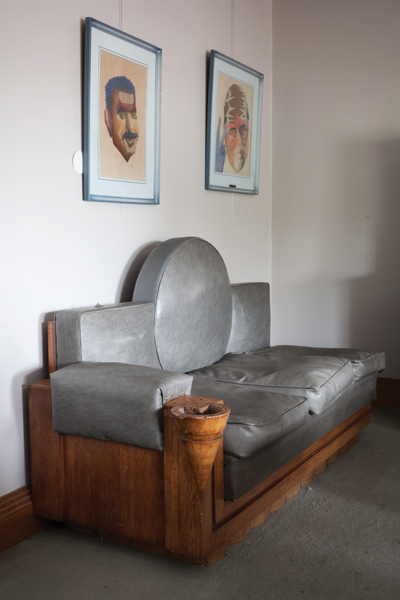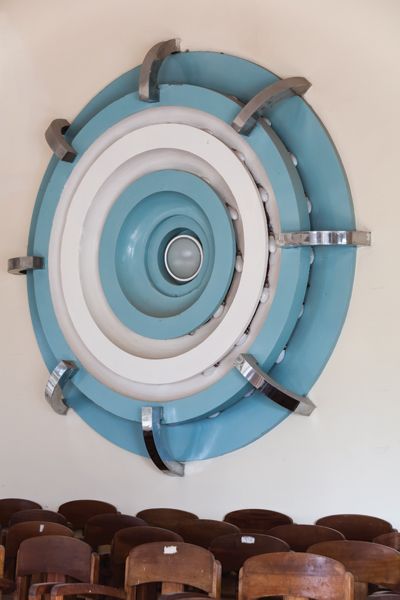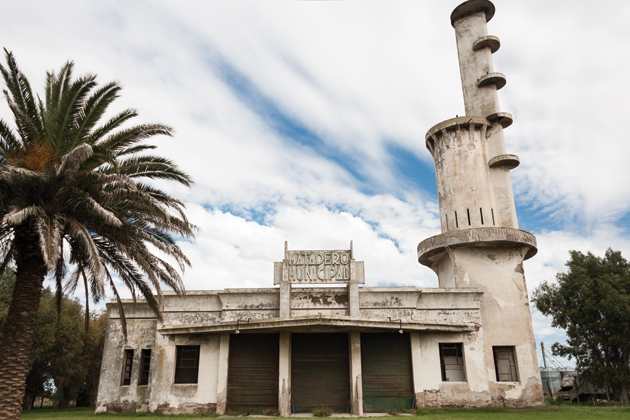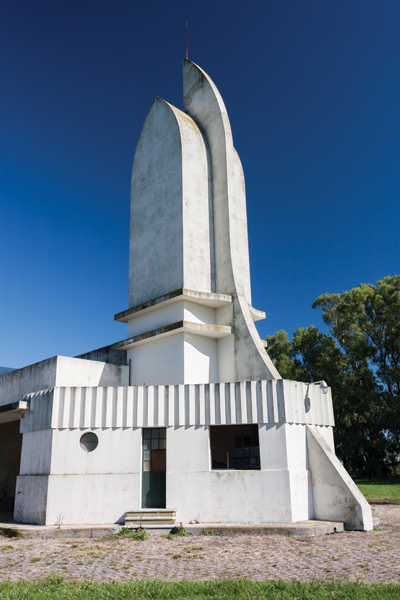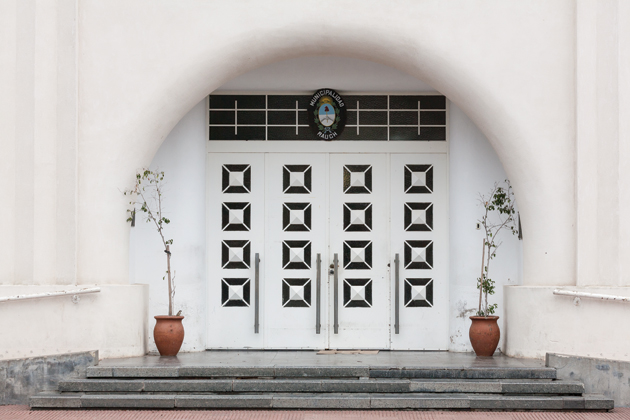|
|
||
|
Over five frenetic years in the 1930s, Francisco Salamone cut a swath across Argentina’s rural east, bringing his own distinctive brand of futurist art deco to all manner of public buildings. While Salamone has been all but forgotten, his extraordinary legacy remains The heartlands of the Pampas, the endless swaths of flat grasslands that characterise the landscape of the rural Buenos Aires Province, seem an unlikely location for experimental architecture. Yet it was here that the Italo-Argentine architect Francisco Salamone built his most unmistakable and significant works, the first examples of modern architecture in rural Argentina. During a prolific period from 1936 to 1940, he completed more than 60 works, including scores of town halls, cemetery portals, slaughterhouses and plazas. They were built across numerous small towns as part of a municipal development programme of unprecedented scale.
Santiago Chierico’s angel of death at Azul cemetery |
Words Vanessa Bell
Photography Emma Livingston |
|
|
||
|
The concave and convex lines of the entrance hall at Laprida’s cemetery
A sofa at Laprida town hall with built-in ashtray
An escarapela (Argentine crest) at Carhué town hall Salamone was born in Sicily in 1897, moving with his family to Argentina shortly after. The son of an architect, he followed in his father’s footsteps and gained a degree in architecture and civil engineering from the National University of Córdoba in 1920, and it was in this city – Argentina’s second largest – that he began to practise his trade. Little is known about his early career, other than that it was beset by failed projects. He fell out with the head of the Central Society of Architects, and also found working for large corporations problematic. In 1932, he was commissioned by the local council in Villa María, a city in Córdoba Province, to work on a variety of public projects, most notably the Plaza Centenario. His experimental approach to the scheme’s central fountain and lighting was a taste of what was to come and this period marked a turning point in his career, when his distinctive style began to take form. |
|
|
|
The main entrance at Azul |
||
|
On moving to Buenos Aires in 1935, he approached the local government and soon made the acquaintance of Manuel Fresco,a doctor, conservative politician and admirer of Mussolini who was elected governor of Buenos Aires Province the following year. The coup d’état in 1930 had marked a shift from a liberal to an authoritarian political ideology, with increasing electoral fraud and corruption. Fresco had generous funds at his disposal, and contracted Salamone and respected architect Alejandro Bustillo to work on his ambitious public building programme. Driven by Fresco’s conservative mandate, the ambition was to instil a sense of pride, order and community spirit in these towns, discouraging the migration that was hampering growth. Fresco fully appreciated the strong association between architecture and ideology, and was aware that Bustillo was a great admirer of the Nazi architect Albert Speer. Yet, based on the correspondence that has survived between the governor and Salamone, it seems the relationship was essentially a professional one, with no suggestion that Salamone shared either his fascist sympathies or his religious faith.
The fountain at Laprida
Carhué’s town hall Salamone was given a remarkable amount of freedom to experiment, with few financial or creative restraints. In a province the size of France, the level of productivity seems almost inconceivable even by today’s standards, averaging more than a work a month over the four-year period. Camping out on site, he was actively involved in every project, delegating only the construction. Influenced by a lifelong love of cinema, he cultivated a uniquely personal style, incorporating elements of art deco, functionalism and futurism, all constructed on an epic scale made viable by the use of reinforced concrete. Salamone’s creations are manifestations of a Hollywoodesque vision of the future. His town halls in particular, with their austere proportions, clean lines and pure facades are clearly influenced by Fritz Lang’s Metropolis and other cinematic and cultural references of the time. |
||
|
The monumental cemetery portal at Saldungaray, with tormented face of Christ carved by Chierico |
||
|
While his projects shared an aesthetic thread, Salamone never duplicated any of his designs, whether for specific building typologies or for the lighting and benches in his town plazas. In particular, cemetery portals and slaughterhouse towers allowed him to experiment outside purely functional design. In the southern town of Coronel Pringles, the square art deco tower on the slaughterhouse is spliced in two by a fin that mimics a butcher’s knife; in Guaminí, the abattoir’s rounded tower is heavily influenced by both expressionism and futurism, with spherical tiered platforms that still give it a space-age appearance today. Unfortunately, there is no centralised body that manages Salamone’s estate – surviving structures are handled locally by individual councils. At Rauch, copies of his plans remain, many ripped and torn from negligence. In addition to detailed drawings for the town hall’s exterior, he also left plans for custom-built furniture and light fixtures – much of it remains in situ, some in use, some untouched. Similarly, an eccentric geometric sofa and armchairs continue to furnish a conference room at Laprida’s town hall.
The entrance hall at Coronel Pringles Salamone left nothing to chance, giving strict instructions of specific species to be planted in each town plaza, carefully considering hardiness and the unique properties of each. He also hired the sculptor Santiago Chierico for many of the municipal projects, who was able to recreate their geometric style – for instance in the distorted facial contours of the guardian angel at the cemetery in Azul, or Christ’s contorted face on the spherical portal at Saldungaray and at the giant crucifixion at the Laprida cemetery. He was also a keen artist, and painted his architectural creations. In Guaminí, two such examples have survived, discovered rolled up in a damp cupboard and now displayed in an office in the town hall. Salamone liked to draw caricatures poking fun at well-known public figures of his time such as Roosevelt and Churchill – these angular portraits, which he affectionately dubbed ‘archicaturas’, were exhibited in 1932. |
||
|
The space-age slaughterhouse at Guaminí |
||
|
Salamone is said to have drunk copious amounts of coffee and smoked up to 100 cigarettes a day, leading to serious health complications in later life, including diabetes and soaring blood pressure. In 1940, when Fresco’s term as governor came to an end, so too did his public building programme, almost as abruptly. Sadly Salamone was never able to match the work he produced during his time under Fresco. He died in relative obscurity in 1959, an event overshadowed by a much-anticipated visit by Greta Garbo to Buenos Aires. There were no mentions in any national newspaper, bar a small paid announcement funded by his family.
A unique lamp design for Azul plaza
The crisp lines of the tower at Azul, reminiscent of a knife
Azul’s plaza at dawn, with crazy paving simulating moving floors and a custom-made bench While his town halls and cemetery portals have weathered well despite their continued use, technological advances in farming have rendered the slaughterhouses obsolete, with subsequent exposure to the elements and pigeon infestations taking their toll. Although his works are now protected by the state, many of Salamone’s personal records have been lost over time, so scant information remains about the man himself or his working processes, fuelling the mystique surrounding his fantastical legacy. A photographic exhibition in Buenos Aires in 1997 to mark the centenary of his birth finally revived interest in Salamone, following decades of obscurity, but it remains to be seen how his astonishing work will be preserved in years to come. |
||
|
The front doors at Rauch town hall |
||





